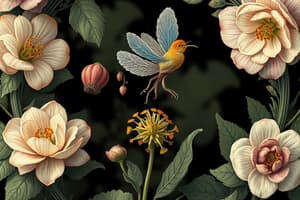Podcast
Questions and Answers
What is the main purpose of flowers in the context of sexual reproduction?
What is the main purpose of flowers in the context of sexual reproduction?
- To serve as symbols for conveying human feelings
- To provide aesthetic and ornamental value
- To attract insects for pollination (correct)
- To be used for human selfishness
Why do flowering plants show sexual reproduction?
Why do flowering plants show sexual reproduction?
- To be used for social, religious, and cultural purposes
- To ensure the formation of fruits and seeds (correct)
- To provide scents and perfumes for human enjoyment
- To create an amazing range of inflorescence structures
What is the significance of the diversity of floral structures in flowering plants?
What is the significance of the diversity of floral structures in flowering plants?
- To create an amazing range of adaptations for human use
- To ensure the formation of end products of sexual reproduction (correct)
- To serve as symbols for conveying human feelings
- To provide a range of colors for attracting humans
What is the role of inflorescences and floral parts in sexual reproduction?
What is the role of inflorescences and floral parts in sexual reproduction?
Why have human beings had an intimate relationship with flowers since time immemorial?
Why have human beings had an intimate relationship with flowers since time immemorial?
Flashcards
Flower's role in reproduction
Flower's role in reproduction
Flowers attract insects to facilitate pollination, a crucial step in sexual reproduction for flowering plants.
Sexual reproduction in plants
Sexual reproduction in plants
Plants use sexual reproduction to create fruits and seeds, ensuring their survival and spread.
Floral diversity purpose
Floral diversity purpose
Flowering plant diversity in floral structures aids in effective pollination strategies, guaranteeing successful reproduction.
Inflorescences and floral parts
Inflorescences and floral parts
Signup and view all the flashcards
Human-flower connection
Human-flower connection
Signup and view all the flashcards
Study Notes
Flowers and Sexual Reproduction
- The main purpose of flowers in the context of sexual reproduction is to facilitate the fusion of gametes (male and female reproductive cells) to produce seeds and fruits.
- Flowering plants exhibit sexual reproduction to ensure genetic diversity and produce offspring with varying combinations of traits, increasing their chances of survival and adaptation.
Diversity of Floral Structures
- The diversity of floral structures in flowering plants is significant because it allows for adaptation to specific environments, pollinators, and reproductive strategies, increasing the chances of successful reproduction.
- Different floral structures have evolved to attract specific pollinators, such as bees, butterflies, or birds, and to optimize the transfer of pollen.
Inflorescences and Floral Parts
- Inflorescences (flower clusters) and floral parts, such as petals, sepals, and stamens, play a crucial role in sexual reproduction by facilitating the attraction of pollinators and the transfer of pollen between flowers.
- The arrangement and structure of inflorescences and floral parts can influence the efficiency of pollination and the likelihood of successful fertilization.
Human Relationship with Flowers
- Human beings have had an intimate relationship with flowers since time immemorial because of their aesthetic, cultural, and symbolic significance.
- Flowers have been used for various purposes, including decoration, ceremony, and communication, and have played a significant role in human art, literature, and culture.
Studying That Suits You
Use AI to generate personalized quizzes and flashcards to suit your learning preferences.




